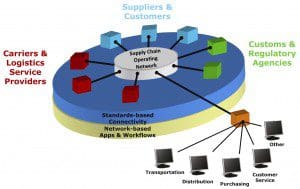When the U.S. economy entered its multi-year recession, many businesses softened the blow by engaging a 3PL to help match slower demand with operational savings. Now that the economy is recovering, some of those same companies are expanding. Since this often involves growing their network of distribution centers, companies are increasingly looking to their logistics partners for something new: real estate advice. When offered this type of opportunity, 3PLs can rise to the occasion by leveraging their experience, tools and a healthy amount of clout in the commercial real estate world. By asking the right questions, staying true to the client’s vision, mining their personal contacts, and staying committed in the long term, 3PLs — known for their expertise in doing more with less — can also be key advisors when it’s time to expand a client’s physical footprint.
If a company engages a good logistics provider to help them locate, lease or buy, and run a new warehouse, the first thing the 3PL should ask is: why does the company need it? Logistics providers understand the strategy behind companies’ desire to physically expand, they understand the pain points, and they understand the drivers. They also understand that more real estate won’t always provide the right solution. Good 3PLs will routinely turn down the potential revenue bump from running a new distribution center for the sake of giving contrary advice, should this be the case, and nurturing a long-term partnership.
Consider a manufacturing client whose recent sales results show solid growth in the Northeast corridor. Encouraged by this success, the client reaches out to its logistics partner to discuss opening a new distribution center in New England. Before doing anything, the logistics provider should help the client determine the origin and sustainability of this spike in business, among other data. They’ll also want to know the company’s growth projections, the characteristics of demand, their forecast inbound and outbound, reverse logistics volumes, and more. When combined with the logistics provider’s wide experience across multiple industries, the client’s answers to these questions won’t only spotlight opportunities, but will also identify the hidden pitfalls likely to color the path ahead.
If a company can’t answer the questions above, or if its roadmap is vague, a good 3PL will help its client understand and articulate general goals and vision for the future — the client’s True North. Only after understanding this unique vision can a logistics provider truly act as a trusted and credible partner, articulating both strategic and fiduciary considerations. Only by putting the client’s needs first and ensuring a new site’s projected ROI is achievable, can a provider help keep a client pointing toward True North. In this way, 3PLs help their clients make wise investment (or non-investment) decisions that complement their continuous improvement roadmap.
Once it is determined that an expansion makes sense, the site search and analysis can begin. Good 3PLs offer a combination of proprietary analytical tools and models, third-party analytical software, and deep subject matter expertise. These assets combine to form an attractive modular solution that clients can pay for in pieces. With each client, logistics providers will run several models to ensure a target property is right. However, most clients fall some degree short of owning all the data needed for those models. Since 3PLs work with other similar clients across different industry segments, they’re able to fill data gaps using assumptive models informed by experience and refined by logic filters, feasibility tests and stress tests. It bears mentioning there are software products on the market which allow companies to internally analyze property metrics, but without complete data and context, these fall short of providing the guidance that a logistics provider can.
Most large 3PLs should also be able to leverage their own real estate procurement arms to ensure their clients get the best deals possible when negotiating property. 3PLs own or operate millions of square feet of warehousing space globally, and this experience qualifies them to advise clients on a very detailed level. Their databases are full of details about various locations, including past demand, freight flows, freight costs, proximity to highways, freight rates in particular markets, and analyses of reverse logistics and return costs for particular product profiles. Often times, a logistics provider’s level of market share also means they have established relationships with major global players in the commercial property space. Because of these relationships, they can help their customers buy or lease more economically and with better terms.
3PLs know that the choice to acquire a new distribution center isn’t just about docks and doors; rather, its real purpose is to support the client’s operations and its success overall. Good 3PLs see the big picture and act as architects for the entire framework, ensuring a smooth process as the facility gets up, running, and fully integrated. To put it another way, the best 3PLs are not only the architects of future success — they’re also its builders and handymen.
Carl Fowler is Senior Director, Business Development and Solutions Design at Menlo Worldwide Logistics. During his nine-year tenure with Menlo, he has worked in transportation, warehouse operations, account management and business development, and has earned a senior leadership role responsible for the company’s 4PL product offering. With an extensive background in manufacturing and warehousing distribution, Fowler has been immersed in the logistics and supply chain industry for more than 18 years.

















